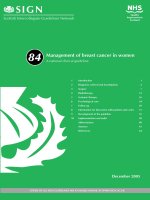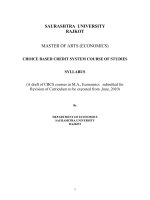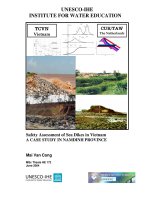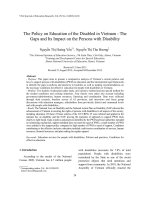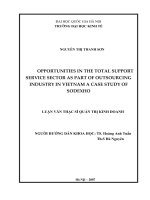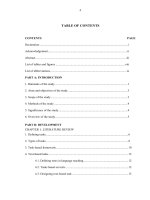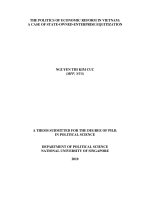Determinants of provincial FDI in vietnam , a cross section data analysis
Bạn đang xem bản rút gọn của tài liệu. Xem và tải ngay bản đầy đủ của tài liệu tại đây (318.93 KB, 63 trang )
UNIVERSITY OF ECONOMICS
HO CHI MINH CITY
INSTITUTE OF SOIAL STUDIES
THE HAGUE
VIETNAM
THE NETHERLANDS
VIETNAM-NETHERLANDS
PROGRAMME FOR M.AIN DEVELOPMENT ECONOMICS
DETERMINANTS OF PROVINCIAL FDI IN VIETNAM:
A CROSS SECTION DATA ANALYSIS
A thesis submitted in partial fulfilment of the requirements for the degree of
MASTER OF ARTS IN DEVELOPMENT ECONOMICS
_
..
By
NGUYEN DAI HIEP
,_,
1•-.
Academic Supervisor:
Dr. NGUYEN VAN PHUC
HO CHI MINH CITY, JANUARY 2011
...
'
.'
DECLARATION
I declare that 'Determinants of provincial FDI in Vietnam: A cross section data analysis'
is my own work, that it has not been submitted for any degree or examination at any
other University, and that all sources used or quoted are indicated and knowledge by
complete references.
January 3, 2011
NGUYEN DAI HIEP
2
ACKNOWLEDGMENTS
This thesis would never have been written if had not for the encouragement, support,
and assistance which I received from large number of people.
Specially, I would like to thank my supervisor, Dr. Nguyen Van Phuc, for his
encouragement, kindness, patience and valuable advices, which helped shape and
improve this thesis. I would also like to thank a few anonymous referees and added
explanatory variables who helped me finalize this work.
I would also like to sincerely thank Prof. Dr. Peter Calkins for his honest and valuable
advices from I begin to choose the topic and TRD completion. He is truly a noble
teacher, who soonest feedback and detail instruction during TRD establishing.
I would also like to thank science committee; all the members of the VietnameseDutch Project for MA programme in Development Economics, University of
Economics-HCMC, VietNam for their support and goodwill, and to all the lecturers,
and also to my friends in the class 15.Thank you a great time!
Last, I want to thank my family members, friends.
Any errors and omissions in this thesis are my sole responsibility.
3
TABLE OF CONTENTS
Declaration .........................................................................................
Acknowledgements ...........................................................................
2
- ...3
Table of contents ..................................................................................
4
Table list ...........................................................................................
6
Abstract ..............................................................................................
7
Chapter 1: Introduction ........................................................................
8
1.1 Problem Statement ...........................................................................
8
1.2 Research Objectives ...........................................................................
8
1.3 Research questions ...........................................................................
9
1.4 Organization of the study .....................................................................
9
Chapter 2: Theoretical Consideration and Literature Review ........................
ll
2.1. The regional development and competitive regionalism theory .....................
11
2.2 FDI theories and its applicability .........................................................
2.2.1 Capital Theory .............................................................
2.2.2 The International Trade Arguments ...........................
11
_....... __ ...... 11
_....................... .12
2.2.3 Market Failures and Industrial Organization ..........................................
13
2.2.4 The Eclectic Paradigm and International Investment Path .........................
. 13
2.2.5 Agglomeration Effect. ....................................................................
14
2.3. Empirical studies on the determinants ofFDI. .........................................
17
2.4. Geographical literature on Vietnam, China and ASEAN countries .................
l9
Chapter 3: Research Model, Data Collection and Variable Description ............
24
3.1. Model Specification .........................................................................
24
3.2 Data Collection ...............................................................................
25
3.3 Variables description ........................................................................
26
Chapter 4: Empirical Estimation and Result .............................................
34
4
4.1 Correlation among explanatory variables............................................................................... 34
4.2 Empirical estimation and result.................................................................................................. .35
Chapter 5: Conclusion and Recommendation............................................................................ .42
5.1 Conclusion and recommendation.............................................................................................. .42
5.2 Limitation........................................................................................................................................... 43
References................................................................................................................................................. 45
Appendices............................................................................................................................................... 49
5
•
TABLE LIST
Table 2.1: Theory summary................................................................................................................... 15
Table 2.2: Empirical Study Reading................................................................................................... 22
Table 3.1: The implementation value of provincial FDI............................................................. .26
Table 3.2: FDI capital of top ten provinces...................................................................................... 26
Table 3.3: PCI result in 2009................................................................................................................ 27
Table 4.1: Matrix of Correlation among explanatory variables ................................................ 34
Table 4.2: Regression Results
. 36
Table 4.3: Top five rank of attracting FDI in Viet Nam............................................................... .38
Table 4.4: The rank of infrastructure in 2009.................................................................................. 39
6
ABSTRACT
FDI is of essential importance for achieving economic growth for developing countries,
especially for Vietnam, a country which has just opened more than twenty years. There
were too many researches about attracting FDI for developing countries. However, there
are still less researches related to regional competition of FDI. Therefore, this paper
examines the relationship between provincial FDI in VietNam and explanatory variables
base on variable set of PCI project in VietNam and other traditional variables. The
purpose of thesis is finding why some provinces and cities such as Binh Duong, Dong
Nai, Ba Ria Vung Tau, HCMC ... have had good FDI capital and others have not so.
From that the thesis suggests policy recommendation for provinces and cities enhancing
regional system for developing economics.
I had a literature review on regional development, attracting regional FDI and across
country, the estimated model was built with collected data and econometric analysis
result, I had demonstrated that our hypotheses are right or wrong. And then we
answered the research questions and objectives of this study. Using data collected by the
General Statistical Office of VietNam (GSO) and Provincial Competition Index (PCI)
project, estimation result shows that gross industrial output, legal institution and
infrastructures statistically significant to provincial FDI at the level 1% and 5%;
business support service had significance to provincial FDI at the level nearly 10%.
Key words: PCI, FDI impact, Provinces in VietNam, cross section data analysis.
7
1.1 Problem Statement
The Provincial Competitiveness Index (PCI) is an effort to explain why some parts of the
country perform better than others in terms of private sector dynamism, job creation and
economic growth and attracting investment (FDI and local). Using new survey data from
businesses that describe their perceptions of their local business environments as well as
credible and comparable data from official and other sources regarding local conditions,
the PCI rates provinces on a 100-point scale. In 2005, the overall index is comprised of
nine sub-indices that explain much of the variation in performance across provinces in
Vietnam. In 2006, new sub-indices were developed to capture other aspects of Provincial
Government efforts to enhance the business environment.
However, we have not found any empirical studies to show that which are independent
variables of PCI and other traditional variables effect to provincial FDI and how to
impact to provincial FDI in VietNam.
I also did not find any analysis related to the independent variables of PCI whether they
have internal relation.
1.2 Research Objectives
The overall goal of this research is to investigate significant impacts of some
independent variables of PCI and other traditional variables which affect provincial FDI
inflows (Regional FDI) to help policy makers to focus on key points and the good points
to improve their investment environment (by Provinces) and with higher level (by
Government).
8
There exist some previous studies related to attracting FDI to developing countries;
most of these have found what factors ofthe country attracting FDI (across countries).
However, the objectives of the thesis are to identify:
(i)
Independent variables of PCI and other traditional variables are significant
impacts to FDI of Provinces in Vietnam; and
(ii)
Factors of PCI are highly correlated and we should revise PCI set.
(iii)
PCI determinants out of the ten original factors should be included in a new,
more significant subset base of PCI determinants.
(iv)
Interaction effects between PCI improvement and FDI growth.
1.3 Research questions
The thesis focus on studying the determinants of provincial FDI in Viet Nam base on
the independence variable set of the Provincial Competitiveness Index (PCI) and other
some traditional variables could be attracting FDI of provinces in VietNam.
We found economic theory, and empirical studies related to FDI (chapter 2), the
description of each independence variable which PCI project in Viet Nam use to survey
(chapter 3). We build research model (specification) and collect the data from PCI
project (www.pcivietnam.org) and statistical yearbook of Vietnam from General
Statistics Office (www.gso.gov.vn) to answer some research questions as following:
(l)Which independent variables of PCI and other traditional variables are significant
impacts to FDI of Provinces in Vietnam?
(2)Factors ofPCI are highly correlated and we should revise PCI set?
(3)Which PCI determinant out of the ten original factors should be included in a new,
more significant subset base of PCI determinants?
(4)Are interaction effects between PCI improvement and FDI growth?
1.4 Organization of the study
This thesis has five chapters, while the chapter one has presented as above explain the
purpose chose the theme. The rest of this thesis is organized as follows:
9
Chapter two briefly provides the regional development and FDI theory, and then we also
have summarized the empirical researches related to attracting FDI, specially related to
attracting FDI across to provinces of the country.
Chapter three is presented how to build the research model base on chapter two, the way
to choose the data. It is important to explain dependent and independent variables which
PCI project have used to survey yearly, also including some traditional variables.
Chapter four is the econometric analysis and finding. The last chapter will be conclusion
and recommendation of the research.
10
2.1 The regional development and competitive regionalism theory
According to Balisacan and Hill (2007), detenninants of regional economic growth in
developing countries are geography and infrastructure, the capacity to connect to global
economy, the quality of local governance and institutions, and the quality of human
capital. Competition regionalism are low corruption, predictable and transparent
businesses environment, secure property rights flexible labor markets, a competitive tax
regime and efficiently supplied public goods.
To Porter (1990), the determinant of national competitive advantage, the nation's in
factors of production are skilled labor, infrastructure, the nature of home demand and
supporting industries. These are potential variables which they could affect to attract
FDI of countries as well of provinces.
2.2 FDI theories and its applicability
There are many reasons for FDI to occur. This, therefore, results in the wide range of
approaches on determinants of FDI. The capital theory takes into account the
consideration of profit rate and risk of firms. In contrast, international trade arguments
focus on substitute or complementary effects between FDI and export. Theories on
industrial organization see FDI as a tool to materialize firm's specific advantages. OLI
paradigm provides dynamic approaches to the determinants of FDI. Finally,
agglomeration economies try to investigate the spatial distribution ofFDI.
2.2.1 Capital Theory
2.2.1.1 Differential Rate of Return Theory
Until the 1950s, international direct investment was entirely explained within the
traditional theory of international capital movements. Like other forms of international
II
investment, FDI was seen as a response to differences in the rates of return on capital
between countries.
2.2.1.2 Portfolio Theory
The investors want to build an efficient portfolio of investment to avoid risk. The rates
of return of the different alternative investments are matched with an element of risk in
the choice between substitutable assets to build an efficient portfolio.
According to Dunning (1973), the reason why portfolio theory can only partially explain
direct foreign investment is that it ignores that "direct investment does not involve
changes in ownership. It does, however, involve the transmission of factor inputs other
than money capital, viz. entrepreneurship, technology, and management
. expertise, and is likely to be affected by the relative profitability of the use of these
resources in different countries as that of money capital".
2.2.1.3 Risk Diversification Theory
The theory argued that the international diversification of portfolios 1s a way of reducing
the firm's risk and hedging the risks.
Capital theory shows that some determinants related cost factors in PCI set have
potential effects to attracting FDI of provinces.
2.2.2 The International Trade Arguments
2.2.2.1 Mundell and the Heckscher-Ohlin Model
Mundell (1975) extended the basic model to show that trade and capital movements can
be substitute. He argued that the introduction of trade tariffs would induce a flow of FDI
towards the protected countries. This argument was the same with original HeckscherOhlin model that restrictions on trade can be modified by international movements of
factors, namely capital, given the immobility of labor.
2.2.2.2 Kojima's "Macroeconomic Approach"
Kojima (1973) groups motives ofFDI into four categories (i) to seek natural resources
(ii) to take advantage of cheap labor cost in the host country (iii) to avoid tariff and
12
non-tariff barriers, and (iv) to take advantage of oligopolistic power owmg to
technology and knowledge advantage.
2.2.2.3 The Product Cycle Model
The product cycle model, developed by Vernon (1966), was a response to the stylized
fact that US firms invested abroad at a rapid rate. Vernon argues that, each product has a
life cycle and will go through three phases: innovation, maturity and standardization.
Domestic demand can be an incentive to innovate, while international demand similarity
stimulates exports. Specifically, the theory described that US endowment of highly
skilled labor and R&D resources, matched with sophisticated domestic demand,
facilitated the innovation among US firms.
2.2.3 Market Failures and Industrial Organization
2.2.3.1 The Hymer-Kindleberger hypothesis
Because foreign firms have necessarily some disadvantages vis-a-vis domestic firms
(e.g., knowledge of the market, communication), they must possess some firm-specific
advantages if they are to engage in foreign production. Hymer (1960) argues that, FDI is
not simply about the transfer of capital, it is about the international transfer of
proprietary rights and intangible assets-technology, business techniques, and skill
personnel's. He claimed that the existence of FDI is exclusively resulted from
international market imperfection for these assets. Therefore, the firms "internalizes or
supersedes" these market failures through direct investment (Hymer, 1960).
2.2.3.2 The Internalization Approach
Some transactions are more cost-saving if it is performed inside the firm than in the
market. Internalization will happen as far as the benefits, including those associated
with the barriers to new entrants is not outweighed by the cost of communication, coordination and control. FDI occur to capture this kind of benefits.
2.2.4 The Eclectic Paradigm and International Investment Path
Dunning ( 1979) suggests that a firm engage in FDI if three conditions are satisfied:
13
It possesses net ownership (0-) advantage vis-a-vis firms from other countries;
It is beneficial to internalize (I- advantage) those advantages rather than to use the market to
pass them to foreign firms;
There are some location (L-) advantages in using the firm's ownership advantages in a
foreign location rather than at home.
The IDP approach deals with both inward investment and outward investment of a country.
It suggests an association between development level of country and its international
investment position (measured by net outward investment per capita). The basic hypothesis
of this approach is that, there exists an interrelationship between the flows of inward and
outward investment and country's development. In other words, as a country develops, the
conditions, which domestic firm and foreign firms face, will change.
2.2.5 Agglomeration Effect
Given rapid rate of globalization in the world today and implicit standardization of strategies
ofMNEs, it is argued that, location determinants ofFDI in host countries are more important
factor determining FDI. In addition, UNCTAD (2001) hypothesizes that although traditional
factors driving FDI may still be relevant; they are diminishing in importance in the era of
globalization, particularly for more dynamic and high-tech industries. Instead, locations of
FDI are seen to be increasingly based on the ability of host countries to provide
complementary skills, infrastructure, suppliers and institutions (UNCTAD, 2001).
Increasing returns in production activities are needed if we want to explain economic
agglomerations without appealing to the attributes of physical geography.
Externalities from agglomeration are known to encompass specialized labor markets and
supplier networks as well as knowledge spillovers.
14
Table 2.1: Theory summary
1
The regional
development
modeling of the determinants of Geography,
regional economic growth m Infrastructure, Legal
developing
countries
are Institutions, Quality of
geography and infrastructure, the human capital;
capacity to connect to global Transparent
economy, the quality of local businesses
governance and institutions, and environment;
the quality of human capital.
Competitive tax
Competition regionalism are low regime and efficiently
corruption,
predictable
transparent
and supplied public goods.
businesses
environment,
secure
property
rights flexible labor markets, a
competitive
tax
regime
and
efficiently supplied public goods.
2
Competitive
advantage theory
The determinant of national Skilled labor,
competitive advantage, the nations infrastructure,
in factors of production is skilled
labor, infrastructure, the nature of
home
demand
and
industries.
15
supporting
supporting industries.
3
Capital Theory
Higher rate of return , leading to
higher attracting FD I
Factor cost: Entry
Cost, Informal
charges, Time Costs of
Regulatory
Compliance
4
Mundell and the Trade tariffs would induce a flow Legal Institutions ,
Heckscher-Ohlin
Model
5
ofFDI
Proactively of
Provincial Leadership
Kojima's
Motiving of FDI into four
"Macroeconomic categories (i) to seek natural
Labor Training,
Access to Land, Legal
Approach"
resources (ii) to take advantage of
Institutions,
cheap labor cost in the host country
Infrastructure
(iii) to avoid tariff and non-tariff
barriers, and (iv) to take advantage
of oligopolistic power
6
The
Product Domestic demand can be an
Market size, Labor
Cycle Model
incentive to
innovate,
while Training, Business
international
demand similarity Support Service ,
stimulates exports.
Provincial Industry
Product
7
The
Hymer- FDI IS not simply about the
Kindle berger
transfer of capital, it is about the
Training labor, Legal
Institutions ,
hypothesis
Proactivity of
international transfer of proprietary
rights
and
intangible
16
assets- Provincial Leadership,
teclmology, business techniques, Business Supp011
and skill personnel's.
Service
8
The
Internalization
Some transactions are more costsaving if it is performed inside the
Approach
firm
than
in
the
Factor cost: Entry
Cost, Informal
market. charges, Time Costs of
Internalization will happen as far
Regulatory
as the benefits, including those
Compliance, Labor
associated with the barriers to new
Training
entrants is not outweighed by the
costof
communication,co-
ordination and control. FDI occur
to capture this kind of benefits.
The purpose of this part, I want to find the basic theory related regional development
and attracting FDI. Although some above theory explains the factors which they attract
FDI in a country but we could review whether or not potential affects to provincial FDI.
2.3 Empirical studies on the determinants of FDI
In general, the conventional empirical studies on determinants of FDI have used the
following ten variables suggested by Dunning and Narula (1996), namely: (i) natural
and created assets; (ii) capital intensity; (iii) market size and market growth; (iv)
infrastructural development; (v) labor cost and productivity; (vi) degree of openness;
(vii) government policies; (viii) political stability; (ix) profitability; (x) geographical
proximity.
Nonnemberg and Mendonya (2004) conducted an analysis on the determinants of
foreign direct investment in developing countries. The econometric model was based on
panel data analysis for 38 developing economies for the period 1975-2000. The
17
L ~·
.
·-...
..
·•
~
.• •..-. J
result shows that one of the major determinants of FDI is education. This in tum
demonstrated that FDI in developing countries has been directed towards activities that
are knowledge-intensive. The coefficient of an economy's degree of openness was found
to be an important factor in attracting investments, and it proved to be highly significant.
Lastly, the au-thors conducted a causality test between FDI and GDP, which showed that
there was evidence of the GOP leading to FDI, but not vice versa.
Ali and Guo (2005) found that base on FDI determinant survey, the results show that the
market size is a major factor for FDI, labour costs and global integration are the main
factor impact to attracting FDI.
Sahoo (2006) conducted a panel cointegration estimation study on the South Asian
region with the main focus on five countries of the South Asian region (India, Pakistan,
Bangladesh, Sri Lanka and Nepal). The results of his analysis reveal that FDI and all its
potential determinants have a long-run equilibrium relationship. He finds out that the
major determinants of FDI in South Asia are market size, labor force growth,
infrastructure index and trade openness. The author concludes also that South Asian
countries need to maintain growth momentum to improve market size, frame policies to
make better use of their abundant labor forces, improve infrastructure facilities and
follow more open trade policies for attracting more FDI.
Kozlova and Smajlovic (2008) reported that the dependent variable in this model is FDI
inflows and the explanatory variables are: GDP per capita, investment freedom, trade
openness and infrastructure. The fact that the country is oil- or non oil-exporting is
represented by the dummy variable.
FDii = ai +
~1
(GDPperCap)i +
~2
(lnvestmentFreedom)i +
~3
(Infrastructure)i +
~4
(TradeOpenness)i + ~5 D (OilExp)i + ui
The general conclusion from the results demonstrates that the infrastructure and trade
openness are significantly related to FDI in the MENA (the Middle East and North
African) region.
18
Vijayakumar et al (20 10) described that other than Economic Stability and Growth
prospects (measured by inflation rate and Industrial production respectively), Trade
openness (measured by the ratio of total trade to GDP) all other factors seem to be the
potential determinants ofFDI inflows in BRICS countries.
Most of FDI researches focused to FDI of a country or some countries but they should
be reviewed to compare these potential explanation variables with independent
variables of provincial FDI.
2.4 Geographical literature on Vietnam, China and ASEAN countries
Xu et al (2009) reported that agglomeration economies, labor cost, infrastructures
greatly influence the spatial distribution ofFDI in China.
Dang (2008) described that based on the analyses in this report, several determinants has
motivated the FDI in China. First, some FDI investors are interested in the Chinese
domestic market. Second, investors would like to find ways to lower production costs,
typically cheap labor from China. Third, the quality of infrastructures contributes much
to FDI inflows. Good infrastructure helps firms to enhance theirs levels of technology
and reap economies of scale and scope. Fourth, the political environment is an important
factor in attracting FDI. In China, the political leadership imposed a vision for the path
of growth and development of the country.
Luo et al (2007) found that the first contribution lies in the finding of this study is a
reminder of the need to further explore the role of natural resources endowment in
stimulating local economic growth and attracting FDI in under-developed regions.
Secondly, instead of advocating China's low labor cost advantage, we found that MNEs
preferentially choose locations that are capable of supporting high value activities rather
than production sites requiring abundant low cost labour.
Havrylchyk and Poncet (2006) found that the positive impact of agglomeration, high
labor productivity and low labor costs, market size, infrastructure density, and market
reforms on FDI.
19
Na and Lightfoot (2006) emphasized that three of the variables have a statistically
significant relationship with FDI in the 30 different regions studied in China. The
relationship between a regions market demand and market size (GDP) was a significant
and positive factor in attracting FDI in 2002 and The higher the quality of labor the more
attractive a region was to FDI, The final variable that exhibited a significant relationship
with FDI was the degree of openness and level of reform in each region.
Giang (2008) reported that there are four local factors including the remote location
from a commercial center of the country, under developed infrastructure, weak FDI
policy and unfavorable FDI environment in comparison with other regions in
Vi~t
Nam.
FDI environment in NMPs (Mountainous Provinces) are not favorable as demonstrated
in the result of annual surveys done by VCCI and VNCI. NMPs except Uto Cai are of
less transparency provinces in
Vi~t
Nam. And six of them are of least transparency
provinces.
Anh and Thang (2007) found that several factors that are important in the location
decision by foreign direct investors in Vietnam such as the marker potential, the labour
factors, and infrastructure. They are unable to find evidence of the impact of local
government policy on FDI.
Anh et al (2007) studied empirical evaluation of incentives effectiveness in attracting
FDI. Implementing the DD estimation in two steps. First, they estimate the following
regression using the method of OLS:
Yst = bO + bl.Xst + b2.Breaks + gst (1)
In which Y st is the level of per capita FDI attracted to provinces in year t; Xst
represents the relevant determinants (or control variables) ofFDI attraction to province s
in year t; Breaks is a dummy (equal to 0 for non-breakers and 1 for breakers.) .The
second step is estimated the impact of the incentives on FDI attraction by using an
20
OLS regression in this two period panel. The regression has a very simple form as
follow:
gsi = b3 + b4.Timesi + usi (2)
Where Timesi represents a dummy (equal 0 for the period before the issuance of the
incentives, and 1 for the period after that). The results are the impact of labour costs
(or wages) appears to be different for registered and implemented FDI. While the
Coefficient of wages is positive and statistically significant in regression (2), it is
negative and statistically insignificant in regression (1 ). This may reflect the different
ways in which labour costs enter the calculation of foreign investors before and after
they actually invest. The negative sign of the wage coefficient in regression ( 1)
implies that, all else being equal, investors tend to choose the investment location
where they can economize on labour costs. Nevertheless, once the investment has
already been implemented, the investor no longer has the luxury of selecting the
location with the lowest labour cost. Moreover, his presence of FDI projects
contributes to relatively scarcer labour, higher productivity, and therefore, higher
wages. This explains why the coefficient of wage in regression (2) is positive.
Thu (2007) studied the determinants of the FDI in Vietnam, the specific empirical
model of the time-series determinants ofFDI inflows in Vietnam is:
LnFDit = po + 81 lnGDPt + 82 lnGDPGt+ 83 lnTELt + 84 lnHKt + 85 lnOPENt + 86
lnEXCHANGEt + 87 Dl998+ 88ASEAN + ut. The results reveal that higher market
size and higher GDP growth are encouraging FDI inflows into Vietnam.
Ali and Ahmad (2008) reported that important factors in determining the location
relationship of FDI in Malaysia are the community, availability of raw materials and
fuel.
21
Table 2.2: Empirical Study Reading
1
Xu et al
(2009)
Spatial Determinants of Inward
FDI in China: Evidence from
agglomeration
economies,
labor cost, infrastructures
Provinces
2
David
(2008)
FDI in China
Economic Growth and Policy
Market size and growth,
Government incentive
policies; Cheap labor cost;
High investment return
3
Na and
Lightfoot
(2006)
4
5
Sahoo
(2006)
Lim
(2001)
Determinants of foreign direct
investment at the regional
market size
(GDP),quality
labor degree of openness
level in China
Foreign Direct Investment
in Market
South Asia:
Policy,
Trends, growth,
stze, labor
infrastructure
Impact and Determinants
and trade openness.
Determinants of the FDI and
growth: a summary of recent
market size, economic
growth, macroeconomic
literature
stability, Infrastructure ,
force
index
regulation, economic barrier
6
Anh and
Thang
Foreign direct
Vietnam: An
investment
m the marker
potential,
overview and labour
factors,
(2007)
analysis
the determinants
spatial
distribution
of infrastructure
across
provmces
22
the
and
7
Thu
(2007)
8
Agiomirgi The determinants of foreign
anakis et direct investment: a panel data
al (2006)
Determinants of the FDI m
Vietnam
market size; GDP growth
the marker size, the trained
labour , and infrastructure
study for the oecd countries
Most of FDI researches focused to FDI of a country or some countries, there are some
researches from China related regional FDI. My thesis focus to provincial FDI in
Vietnam (regional FDI) base on independent variables of PCI set and other some
traditional variable.
23
3.1 Research Model
Base on Vietnam PCI project proposed general framework for determinants of provincial
competition index as follows:
PCiit= f(EC it. ALit. TAl it. TCRC it. IC it. PPL it. BSS it. LT it. Liit. INF it. uit) (1)
Where: EC-Entry Costs, AL-Access to Land , TAl-Transparency and Access to
Information , TCRC-Time Costs of Regulatory Compliance , IC _Informal Charges ,
PPL-Proactivity of Provincial Leadership ,BSS- Business Support Service ,LT- Labor
Training, LI-Legal Institutions, INF- infrastructure.
Base on empirical studies related to FDI, especially regional FDI, economic theory and
base on PCI survey as equation ( 1), the research question is
(i) Which independent variables of PCI and other traditional variables are significant
impacts to FDI of Provinces in Vietnam?,
The first regression model for this study is suggested as follow:
FDI it= a o +a 1 EC it+ a 2 ALit+ a 3 TAl it+ a 4 TCRC it+ as IC it+ a 6 PPL it+ a
1 BSS it +as LTit +a 9 LI it+ o.w IP u +an INF it+ o.n MS it
+ o.13 KEA it +
u it
(2)
Where: IP-Industrial Product of province, MS-Market Size, KEA: northern and southern
key economic area KEA = 1, other provinces KEA=0
The OLS technique applies for the first regression model to answer for the first research
question
Base on economic theory and principle component analysis we expect to find
multicollinearity or significant interaction effects among some of these as following
24
explanation. Some independent variables can be dropped off to two group Cost Factors
and Province Policy
Where: CF: Cost Factor (including EC, TCRC, and IC), PP: Province Policies
(including AL, TAl PPL, BSS, LT, and LI). And it should be reviewed to add other
significant variables. This method is applied to answer for research question No.2 and
No.3.
The first regression model (2) for this study is a distribution determinants model of total
FDI in province; we use the logarithm of annual FDI of province as a dependent
variable in order to emphasize the growth rate of FDI:
Ln (FDI) it
=
fJJ + f32Ln (PC!) it+ uit (3)
Where, i and t denote sample provinces, and time (year) respectively. !.! denotes
residuals.
To answer for research question No.4, The OLS technique also applies.
3.2 Data Collection
There are two types of panel data: Balanced versus non-balanced data
Balanced case: i = 1, 2, ... , N t = 1, 2, ... , T
Unbalanced case: i = 1, 2, ... , N t = 1, 2, ... , Ti
Or: t = tj 1, tj2 , ... , tjTi
Two limit cases are a "pure" cross section data with only one time period or a "pure"
Time-series data with only one individual
I collected the panel data (dependent and independent variables) from PCI project
(www.pcivietnam.org) and statistical yearbook of Vietnam from General Statistics
Office(www.gso.gov.vn) for all provinces in Vietnam in years 2006 to 2009 with 252
observations( 4 years x 63 provinces ) and have counted to cross section data by getting
the average value in four years (63 observations) .We only can get registered FDI data
of provinces in VietNam and use the weight ( 0.33) in three years (2007-2009) of the
implementation value of provincial FDI as following:
25

